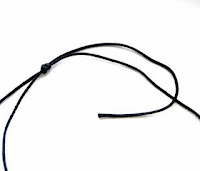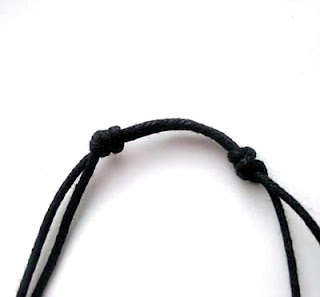This weekend I was explaining to a friend how to tie an adjustable slip knot to hang a pendant and remembered I had posted a tutorial on it for the Etsy Ireland blog about two years ago. So I thought I'd redo the post here on my own blog: This tutorial is a little hard to photo so I hope it's easy to follow.
This is a really simple project, easy enough for those of you who can't bead or wont bead and just want to hang a pendant, ID badge or charm. You can also apply this technique to make a bracelet.
First get a long piece of chord. I find that leather, suedette or waxed cotton tend to work best. Ribbon isn't great. You need something that has grip yet will allow the knot to slide. It needs to be long enough to fit over your head + 8 inches. About 32 inches is a decent, workable length if you are medium to plus sized. Some may need a shorter piece, or longer piece. Whatever works for you.
Pull that short end through the loop, (to the left) while at the same time pulling the longer strand on the far side of the knot in the opposite direction. (Do it slowly to check you are pulling the correct two pieces! If the knot isn't tightening and only moves, then you are tugging the wrong long strand.) The knot should be tightening and look like this.
You should end up with something like this. Now tie the other side to create a second knot. Just mirror what you just did, working to the right this time. Then tighten that knot too.
Hang your pendant or charm in the middle of the chord before tying the necklace. Place the two loose ends of the chord flat on the table as pictured then fold one end over the other as shown.
Now bring the loose end of the folded piece away from you, back under the other strands. Then wrap it back over the top of the strands, towards you again.
Repeat this two or three times, wrapping the chord over itself, working towards the bend in the loop you've created (to the left in these photos.)
On the final wrap, bring the short loose end through the loop as in the photo. (For simplicity's sake I have only wrapped a couple of times here, but an extra wrap would be more secure.)Pull that short end through the loop, (to the left) while at the same time pulling the longer strand on the far side of the knot in the opposite direction. (Do it slowly to check you are pulling the correct two pieces! If the knot isn't tightening and only moves, then you are tugging the wrong long strand.) The knot should be tightening and look like this.
Tada! Two knots that you can slide away from each other to shorten the chord once it is over your head and slide towards each other to lengthen.
You can trim the loose ends close to the knot, leaving a small piece free to ensure the knot's stability. Depending on what material you have used, you may seal the end to prevent fraying using clear nail varnish, a drop of glue or in the case of leatherette, by carefully singing it. (Caution!!! And not to be carried out by children). Do not get glue or varnish onto the knot itself or it wont slide.
I hung this turquoise blue stone and copper pendant, 'Temptress,' on a long length of brown suedette using this technique.
You can trim the loose ends close to the knot, leaving a small piece free to ensure the knot's stability. Depending on what material you have used, you may seal the end to prevent fraying using clear nail varnish, a drop of glue or in the case of leatherette, by carefully singing it. (Caution!!! And not to be carried out by children). Do not get glue or varnish onto the knot itself or it wont slide.














Ah! Thank you for this! I had a friendship bracelet with this knot in it when I was a kid, (but apparently the friendship didn't go as far as her telling me how she did it!) and I've always wondered how it was done! Now I know. :D
ReplyDeleteThank you....most useful!
ReplyDelete